
In Hindu tradition, Goddess Lakshmi is not just the giver of wealth, but also of courage, wisdom, success, and fertility. To bless every aspect of life, she manifests in eight divine forms collectively known as Ashtalakshmi. These sacred forms symbolize the eight kinds of wealth essential for a fulfilling life—ranging from material riches to inner strength and knowledge.
Knowing the Ashtalakshmi names in order and their deeper meanings invites divine grace into your home and heart.
Below, we have shared the 8 Lakshmi names, their beautiful significance, benefits of worship, and their symbolic appearances. You’ll also find God Ashtalakshmi images, mantras, and insights to deepen your devotion.
What Does Ashtalakshmi Mean?
The word Ashtalakshmi comes from Sanskrit:
- “Ashta” means eight
- “Lakshmi” refers to the Goddess of wealth and prosperity
Together, Ashta Lakshmi represents the eight divine forms of Goddess Lakshmi, each blessing a different aspect of life—like wealth, courage, food, knowledge, progeny, victory, and more. These eight forms are not separate goddesses, but manifestations of the one supreme Lakshmi Devi, who nurtures both material and spiritual abundance.
In Hindu tradition, wealth (Lakshmi) is not limited to money. True prosperity includes knowledge, strength, good health, children, inner peace, and success. Each form of Ashtalakshmi reflects this holistic view of abundance.
Devotees often worship Ashtalakshmi in a specific order, recite the Ashtalakshmi Stotram, and place God Ashtalakshmi images in their homes to invite balance, grace, and blessings in all areas of life.
Ashta Lakshmi Names in Order (With Meaning)
Below are the Ashtalakshmi names with meaning, significance, and symbolism:
| Ashta Lakshmi Name | Meaning | Significance | Symbolism |
| Adi Lakshmi | The Primordial Goddess | Grants spiritual strength and peace | Lotus, gold pot, mudra of blessing |
| Dhana Lakshmi | Goddess of Wealth | Provides material riches and prosperity | Gold coins, elephant, decorated attire |
| Dhanya Lakshmi | Goddess of Grains | Ensures food, nourishment, and health | Rice, sugarcane, fruits, green garments |
| Gaja Lakshmi | Elephant Lakshmi | Symbol of power, royalty, and honor | Two elephants, lotus, water pot |
| Santana Lakshmi | Goddess of Progeny | Blesses with children and family growth | Child in hand, kalasha, weapons |
| Veera Lakshmi | Goddess of Courage | Gives strength, bravery, and resilience | Weapons, armor, protective posture |
| Vijaya Lakshmi | Goddess of Victory | Ensures success in life and ventures | Abhaya mudra, lotus, sword |
| Vidya Lakshmi | Goddess of Knowledge | Blesses with wisdom, learning, and skill | Book, white saree, veena, calm face |
1. Adi Lakshmi (आदि लक्ष्मी)
Adi means first or primordial. As the name of Ashta Lakshmi’s earliest form, Adi Lakshmi represents the eternal source of creation, abundance, and divine knowledge.
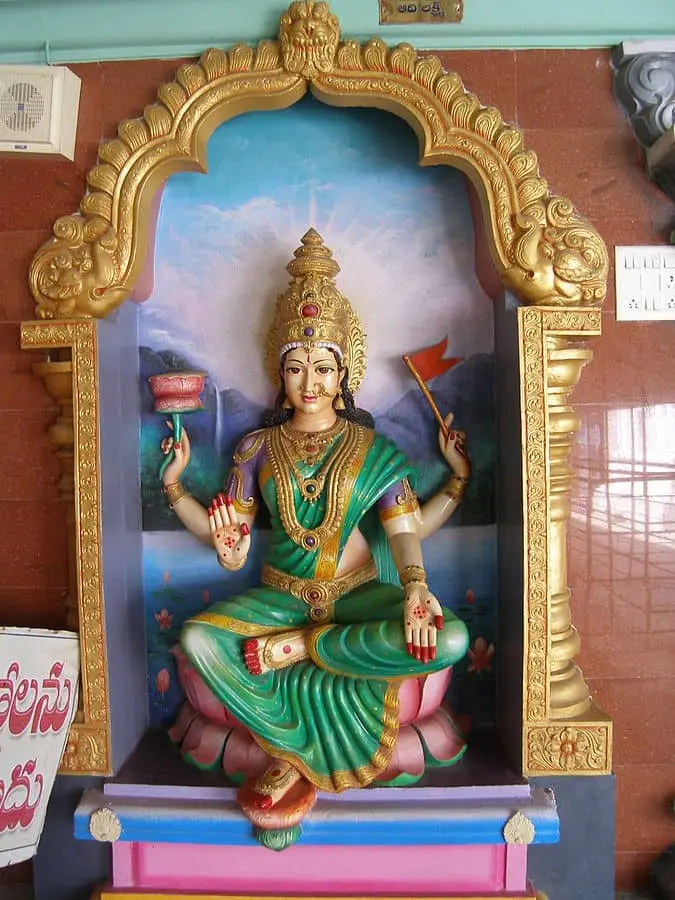
Story of Adi Lakshmi:
Adi Lakshmi is believed to be the most ancient among the Lakshmi avatars. She is said to have been present during the churning of the cosmic ocean (Samudra Manthan), where gods and demons sought divine treasures.
According to scriptures, Sage Bhrigu once pleaded for Adi Lakshmi to awaken from her deep meditation, as the universe had not received her grace for a long time.
She is revered as the womb of creation, from whom all existence—gods, goddesses, and the elements—sprang forth. This is why Adi Lakshmi is not only associated with spiritual awakening and wisdom but also fertility, motherhood, and married women. Offering her red flowers symbolizes desire and divine love.
Significance and Blessings:
She blesses her devotees with spiritual wealth, clarity of life’s purpose, and the strength to fulfill their Dharma. She helps you understand what is truly valuable in life, and provides what is needed to achieve your highest goals.
Adi Lakshmi Symbolism and Iconography:
- Calm face, often seated on a lotus
- Holds a lotus, flag, and gestures of protection and blessing
- Symbolizes timeless wisdom and serenity
Ideal For Whom:
Those seeking spiritual direction, fertility blessings, or clarity in life should worship Adi Lakshmi. She is among the most powerful maa Lakshmi names and is also revered by married women and spiritual seekers.
Top Trending Content on hellomyyoga:
2. Dhana Lakshmi (धन लक्ष्मी)
Dhana means wealth or money. Dhana Lakshmi is the Goddess of Material Prosperity, one of the most worshipped among the 8 Lakshmi names. She represents financial abundance, good fortune, and success in worldly life.
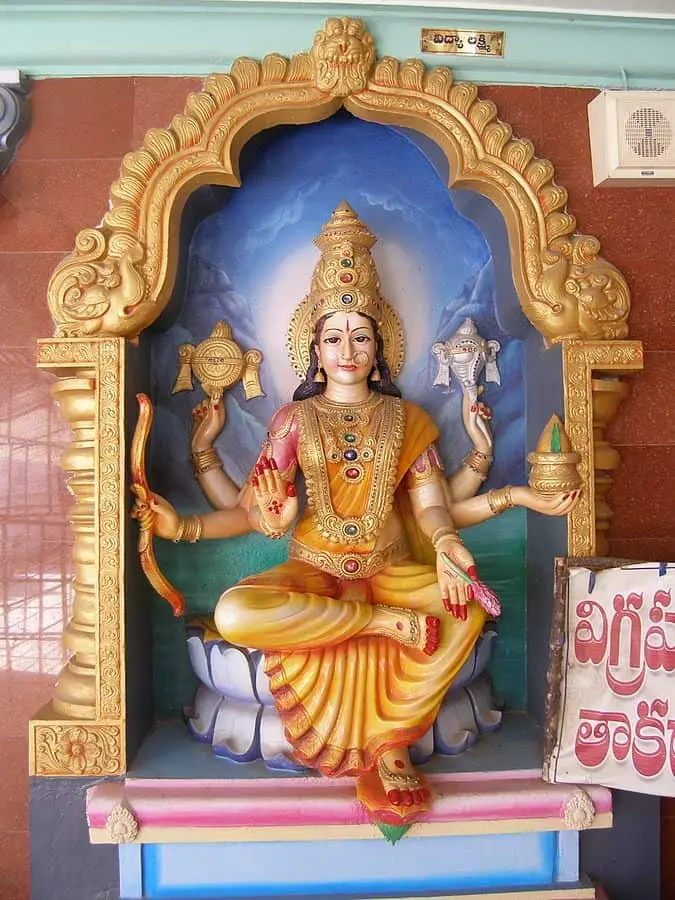
Mythological Story of Dhana Lakshmi:
In Hindu mythology, Dhana Lakshmi is said to be the deity of wealth and prosperity. Her story begins when she became angry with Lord Vishnu for his perspective on money. Upset, she left Vaikunta (heaven) and descended to Earth.
Lord Vishnu, realizing her absence, followed her to Earth and lived like a poor man in the forest. Eventually, the two met again, but reconciliation did not occur immediately, as Lord Vishnu was still in poverty. He had borrowed wealth from Kubera, the god of riches, but couldn’t repay the debt.
Years passed before Lord Vishnu truly understood the value of money and wealth in the worldly realm. Recognizing this, Dhana Lakshmi forgave him and blessed him with riches once again. From that moment, she became the embodiment of prosperity for those who respect and use wealth wisely. Her story teaches that wealth is sacred when earned through hard work and used righteously.
Significance and Blessings:
Dhana Lakshmi, a powerful avatar of Lakshmi, blesses her devotees with wealth, fame, generosity, and fortune. She removes financial obstacles and ensures material abundance. As one of the most well-known Lakshmi avatars, her blessings are sought by businesspeople, entrepreneurs, and householders.
Dhana Lakshmi Symbolism and Iconography:
- Appearance: Radiant, adorned with jewelry and golden garments
- Items Held: Showering gold coins, lotus, conch, and chakra
- Vehicle: Elephant or owl
Her image shows her blessing devotees while gold coins pour from her hand, symbolizing unending prosperity.
Ideal For Whom:
Those seeking financial stability, success in career or business, or wishing to overcome debts and poverty should worship Dhana Lakshmi. She is also one of the most important Lakshmi Mata names in Diwali and Lakshmi Puja traditions.
3. Dhanya Lakshmi (धान्य लक्ष्मी)
Dhanya means grains or food. Dhanya Lakshmi is the provider of nourishment, health, and agricultural wealth. She is one of the essential Lakshmi avatars who sustains life itself.
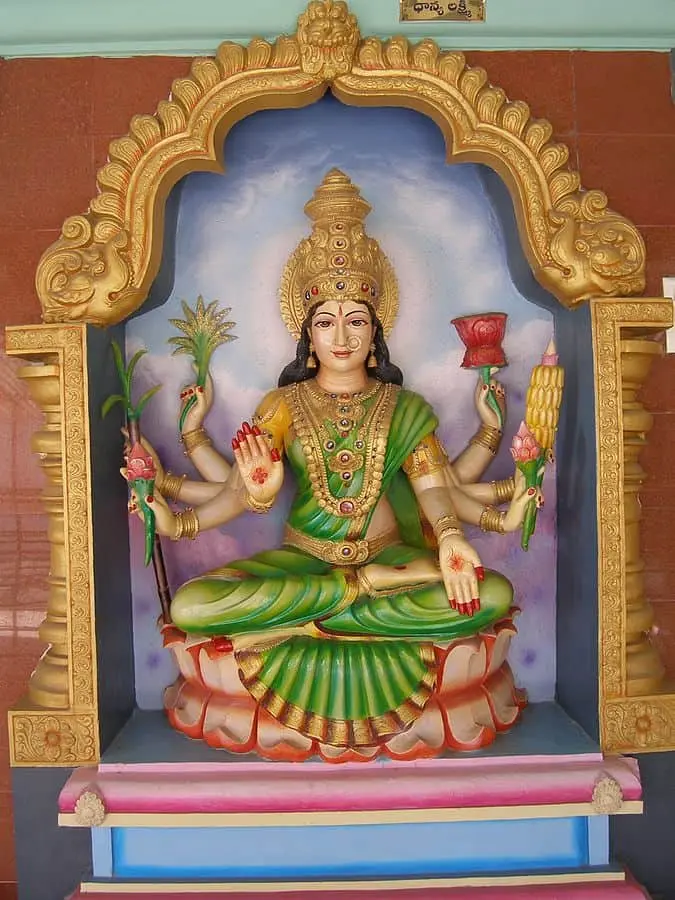
Mythological Story of Dhanya Lakshmi:
According to belief, when the Earth was suffering from famine, Mother Dhanya Lakshmi emerged from the divine realm to bless humanity with grains and fertility of the soil. Farmers prayed to her during droughts, and wherever she walked, crops bloomed.
She restored balance between nature and mankind by teaching the value of natural food, self-reliance, and offering gratitude to the Earth.
Significance and Blessings:
She ensures that her devotees never lack food, health, or shelter. She’s also considered the protector of organic living, nourishing body, mind, and soul.
Dhanya Lakshmi Symbolism and Iconography:
- Holds sugarcane, bananas, sheaves of paddy, and a lotus
- Dressed in green, symbolizing fertility and prosperity
- Surrounded by grains, fruits, and vegetables
Ideal For Whom:
Farmers, homemakers, food producers, and those seeking health and abundance should worship Dhanya Lakshmi. She is one of the vital 8 Laxmi names that ensures daily sustenance and natural wealth.
4. Gaja Lakshmi (गज लक्ष्मी)
Gaja means elephant. Gaja Lakshmi is the Goddess of power, royalty, and prestige, often associated with royalty and restoration.
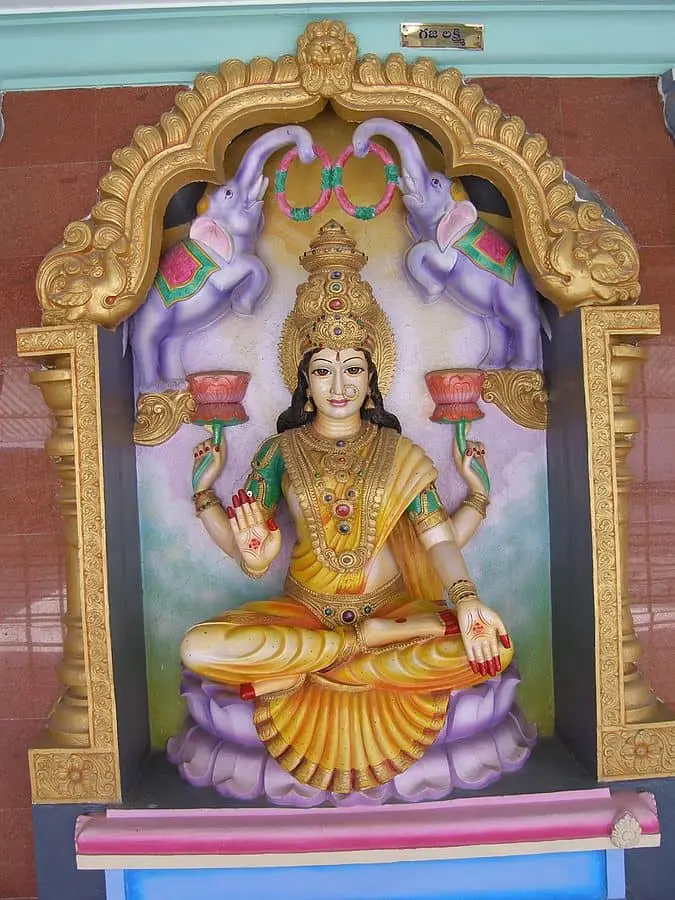
Story of Gaja Lakshmi:
Gaja Lakshmi is said to have restored the lost glory of Indra, the king of the gods, after it was taken by demons during Samudra Manthan. She emerged from the ocean seated on a lotus, flanked by two white elephants pouring water over her—symbolizing divine abundance, wealth, and majesty.
Significance and Blessings:
She blesses devotees with power, respect, reputation, and social status. She’s worshipped for restoring lost glory and attracting royal grace and influence.
Gaja Lakshmi Symbolism and Iconography:
- Two white elephants showering her with water
- Dressed in red or gold
- Holds lotus, gold pot, and mudras of blessing
Ideal For Whom:
Leaders, professionals, and those seeking name, fame, and honor should worship Gaja Lakshmi. She’s also one of the most iconic goddess Lakshmi different names in temple worship.
5. Santana Lakshmi (संतान लक्ष्मी)
Santana means offspring or children. Santana Lakshmi is the Goddess of fertility, children, and family legacy.
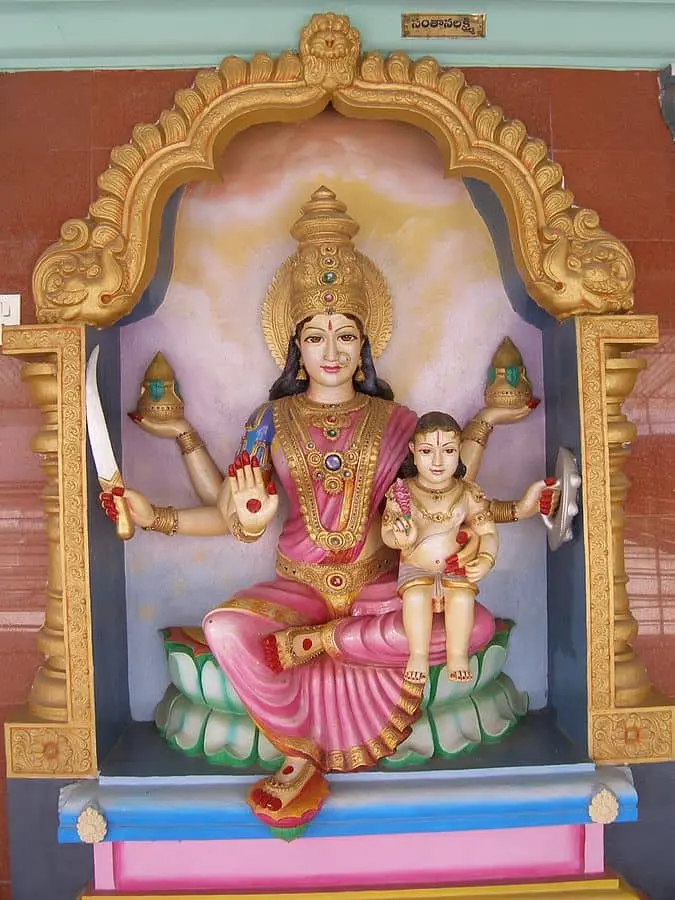
Story of Santana Lakshmi:
Legend says that when several royal couples could not bear children despite divine blessings, Santana Lakshmi appeared and fulfilled their prayers. She not only blessed them with healthy children but also with a nurturing environment to raise them with wisdom, strength, and devotion.
Significance and Blessings:
She grants the blessing of progeny, safe childbirth, and protection of children. Her energy also fosters emotional bonding within families.
Santana Lakshmi Symbolism and Iconography:
- Holds a child, sword, shield, and two lotuses
- Accompanied by young children or shown blessing couples
Ideal For Whom:
Couples trying to conceive or parents praying for the wellbeing of their children should worship Santana Lakshmi. She is one of the revered Lakshmi mata names in family rituals.
Meditation Topics for You:
6. Veera Lakshmi / Dhairya Lakshmi (वीर लक्ष्मी / धैर्य लक्ष्मी)
Veera means valor, and Dhairya means courage. This form represents bravery, strength, and inner fortitude.
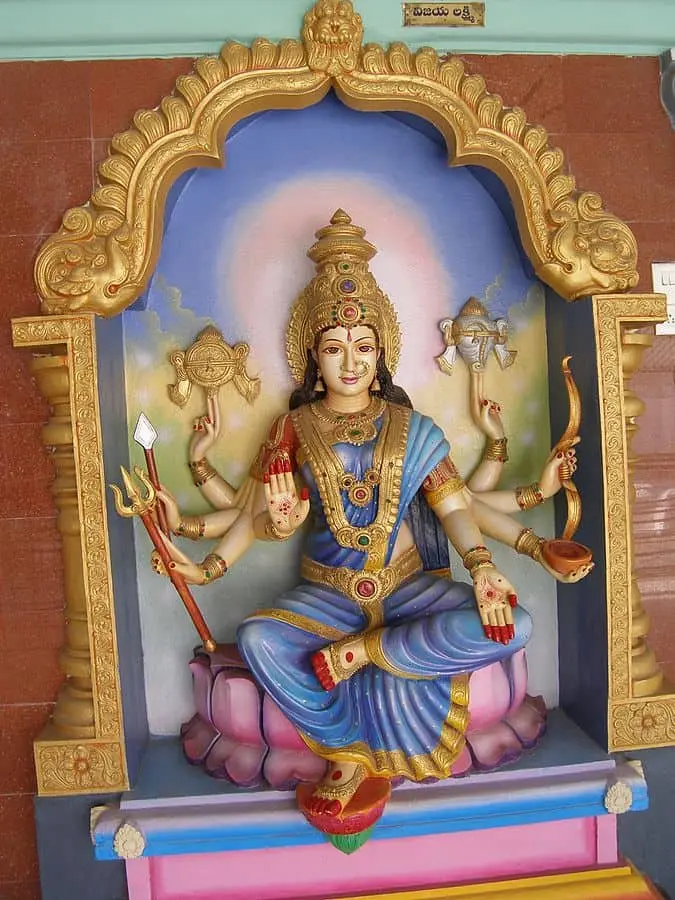
Story of Veera Lakshmi:
When gods and sages were under threat from demonic forces, Veera Lakshmi emerged with weapons in hand, riding a lion. She gave courage to warriors and inspired victory in battle. She is also invoked during times of personal crisis or when fighting injustice.
Significance and Blessings:
She blesses her devotees with courage, confidence, and resilience to face adversities. She is often seen as the spiritual strength behind righteous battles.
Symbolism and Iconography:
- Holds chakra, conch, sword, shield, and lotus
- Dressed in red or golden armor
- Seated on a lion or standing powerfully
Ideal For Whom:
Those facing challenges, fear, legal issues, or emotional breakdowns can seek the blessings of Veera Lakshmi—a powerful Lakshmi synonyms for strength.
7. Vijaya Lakshmi (विजय लक्ष्मी)
Vijaya means victory or success. Vijaya Lakshmi is the Goddess of triumph over obstacles—material or spiritual.
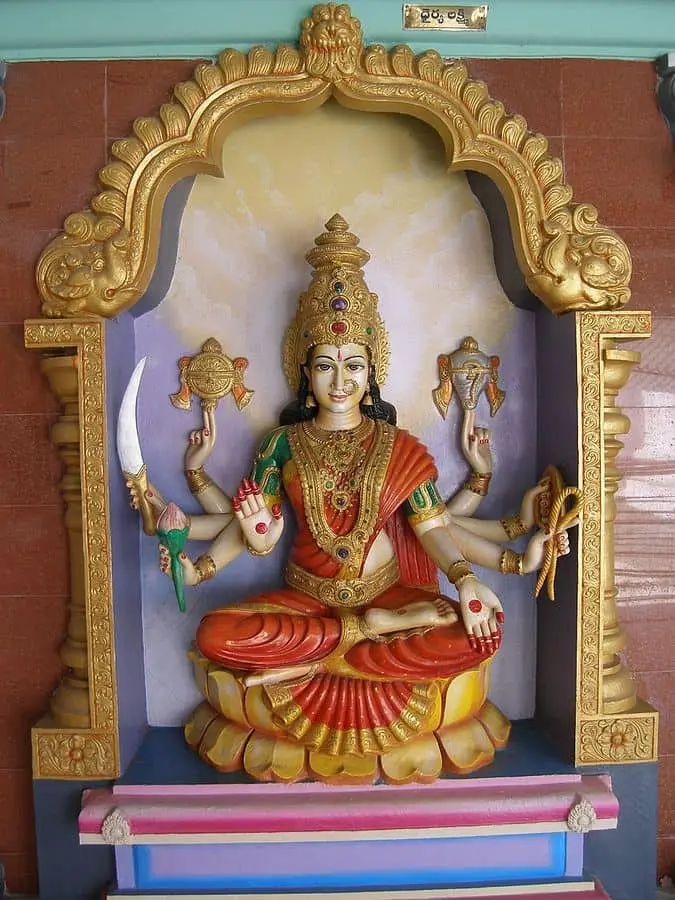
Story of Vijaya Lakshmi:
It is said that during times of immense struggle, when even gods lost hope, Vijaya Lakshmi appeared as a radiant force. Her blessings turned tides in their favor, ensuring victory through faith and perseverance.
Significance and Blessings:
She grants success in all ventures, spiritual pursuits, and life goals. Whether exams, jobs, legal matters, or inner battles—her blessings ensure a positive outcome.
Symbolism and Iconography:
- Holds lotus, discus, shield, sword
- Often in a posture of victory with divine glow
- Depicted with eight arms
Ideal For Whom:
Students, professionals, or anyone striving for success should worship Vijaya Lakshmi, a powerful other names of Mahalakshmi worshipped during Navratri.
8. Vidya Lakshmi (विद्या लक्ष्मी)
Vidya means knowledge. Vidya Lakshmi is the Goddess of wisdom, intellect, and learning.
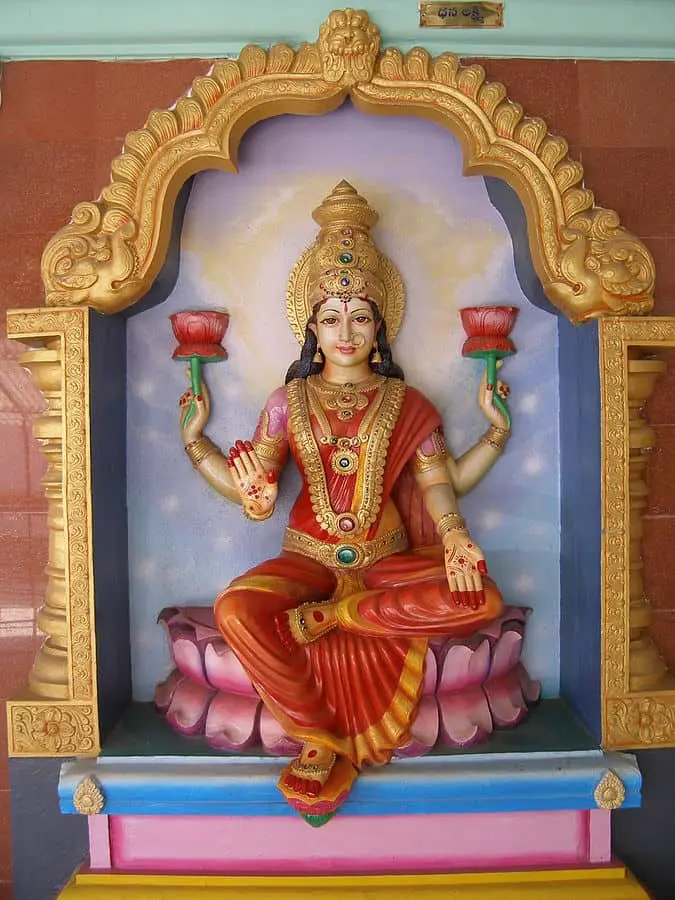
Story of Vidya Lakshmi:
Vidya Lakshmi is said to have blessed Saraswati, the goddess of knowledge, with divine radiance. When sages sought knowledge beyond rituals, Vidya Lakshmi appeared to teach them higher truths and guide them to enlightenment.
Significance and Blessings:
She blesses her devotees with academic success, clarity of thought, and decision-making power. She supports both intellectual and spiritual knowledge.
Symbolism and Iconography:
- Dressed in white
- Holds a book, lotus, and writing tools
- Often seen seated on a lotus with a calm demeanor
Ideal For Whom:
Students, teachers, scholars, and lifelong learners should worship Vidya Lakshmi—a divine Lakshmi mata name for success in studies.
Yoga Information:
Ashta Lakshmi Names in English
- Adi Lakshmi
- Dhana Lakshmi
- Dhanya Lakshmi
- Gaja Lakshmi
- Santana Lakshmi
- Veera Lakshmi
- Vidya Lakshmi
- Vijaya Lakshmi
Ashta Lakshmi Names in Hindi
- आदि लक्ष्मी
- धन लक्ष्मी
- धान्य लक्ष्मी
- गज लक्ष्मी
- संतान लक्ष्मी
- वीर लक्ष्मी
- विद्या लक्ष्मी
- विजय लक्ष्मी
Ashta Lakshmi Names in Telugu (in Order)
- ఆదిలక్ష్మి
- ధనలక్ష్మి
- ధాన్యలక్ష్మి
- గజలక్ష్మి
- సంతానలక్ష్మి
- ఆదిలక్ష్మి
- విద్యాలక్ష్మి
- విజయలక్ష్మి
Ashta Lakshmi Names in Kannada
- ವಿಜಯ ಲಕ್ಷ್ಮಿ
- ಆದಿ ಲಕ್ಷ್ಮಿ
- ಧನ ಲಕ್ಷ್ಮಿ
- ಧಾನ್ಯ ಲಕ್ಷ್ಮಿ
- ಗಜ ಲಕ್ಷ್ಮಿ
- ಸಂತಾನ ಲಕ್ಷ್ಮಿ
- ಧೈರ್ಯ ಲಕ್ಷ್ಮಿ
- ವಿದ್ಯಾ ಲಕ್ಷ್ಮಿ
Ashtalakshmi Stotram and Its Importance
The Ashtalakshmi Stotram is a sacred hymn dedicated to the eight forms of Goddess Lakshmi, collectively known as Ashta Lakshmi. Composed in Sanskrit, this powerful stotra is chanted to invoke the blessings of each avatar of Lakshmi Devi—Adi Lakshmi, Dhana Lakshmi, Dhanya Lakshmi, Gaja Lakshmi, Santana Lakshmi, Veera Lakshmi, Vijaya Lakshmi, and Vidya Lakshmi.
The stotram was composed by Sri U.V. Srinivasa Varadachariar, a great scholar and devotee. It consists of 8 main verses, each devoted to one form of Lakshmi, followed by a concluding shloka (phala shruti) that describes the benefits of reciting the hymn.
Below is why the Ashta Lakshmi Stotram is important:
- Invokes all 8 types of wealth and prosperity: Not just money, but food, courage, children, wisdom, and success
- Balances material and spiritual life
- Removes obstacles, financial troubles, and negativity
- Ideal for daily chanting or on Fridays, Diwali, Varalakshmi Vratam, and Navratri
- Brings harmony, peace, and abundance into family life
Many devotees recite the stotram daily or on auspicious days with faith and devotion, often in front of Ashta Lakshmi images or yantras. It is said that chanting this stotra with a pure heart attracts the grace of Mahalakshmi in all her divine forms.
Ayurveda Content to Read:
Festivals and Days for Ashtalakshmi Worship
Worshipping the Ashta Lakshmi, or the eight forms of Goddess Lakshmi, is a sacred practice in many Hindu households, especially in South India. While Lakshmi Devi is worshipped daily in some homes, there are specific festivals and days considered highly auspicious for invoking all 8 Lakshmi names together.
1. Varalakshmi Vratam
- Celebrated during the Friday before Raksha Bandhan (Shravan month)
- Especially popular in Tamil Nadu, Andhra Pradesh, Telangana, and Karnataka
- Married women observe fast and perform Ashta Lakshmi puja to seek blessings for prosperity, family harmony, and well-being
2. Diwali (Deepavali)
- Most significant festival for Lakshmi worship
- On Lakshmi Puja (third day), devotees worship Mahalakshmi in all her forms, including Ashta Lakshmi, for wealth and happiness
- Homes are decorated with lights and rangoli, and special pujas are performed at night
3. Sharad Purnima / Kojagiri Purnima
- Celebrated on the full moon night of Ashwin month
- It is believed Goddess Lakshmi descends to bless devotees who stay awake and chant her names, especially Maa Lakshmi names and Ashtalakshmi stotra
4. Fridays (Especially in Tamil Nadu)
- Fridays are considered sacred for Lakshmi worship
- Devotees perform Ashtalakshmi pooja or chant the Ashtalakshmi Stotram
- Offerings like lotus flowers, turmeric, kumkum, and sweets are made
5. Navratri (Nine Nights of the Goddess)
- Especially the days dedicated to Maha Lakshmi in the middle 3 days
- Some traditions worship a different avatar of Lakshmi each day, invoking all Lakshmi synonyms and blessings
6. Margashirsha Month (Lakshmi Maas)
- The month of Margashirsha (November–December) is considered Lakshmi’s favorite
- Devotees chant Mahalakshmi Ashtakam and Ashtalakshmi Stotram throughout the month
Benefits of Worshipping Ashta Lakshmi
- Wealth and Financial Stability: Receive blessings of Dhana Lakshmi, who removes poverty and blesses you with money, business growth, and fortune.
- Food and Nourishment: With the grace of Dhanya Lakshmi, one enjoys abundance in grains, health, nutrition, and a well-stocked home.
- Power and Social Status: Gaja Lakshmi bestows authority, royal status, dignity, and recognition in both personal and professional life.
- Wisdom and Education: Vidya Lakshmi blesses students, teachers, and seekers with clarity of thought, memory, intelligence, and academic success.
- Courage and Strength: Veera Lakshmi gives mental and emotional courage to overcome fear, anxiety, and tough situations in life.
- Victory and Success: Vijaya Lakshmi ensures triumph in competitions, exams, business ventures, legal matters, and life’s challenges.
- Children and Family Growth: Santana Lakshmi grants the blessing of healthy progeny, smooth childbirth, and happiness in family life.
- Spiritual Growth and Inner Peace: Adi Lakshmi, the primordial goddess, blesses with devotion, self-realization, and inner peace, guiding one toward liberation (moksha).
Yoga for Health:
| Yoga for High Blood Pressure | Yoga for Anxiety | Yoga for Metabolic Syndrome |
| Yoga for Bipolar Disorder | Yoga for Endometriosis | Yoga for Lower Back Pain |
| Yoga for Depression | Yoga During Periods | Yoga for PCOD |
Famous Ashtalakshmi Temples in India
These are the top Ashta Lakshmi temples:
1. Ashtalakshmi Temple, Chennai (Tamil Nadu)
Location: Besant Nagar, Chennai
The most well-known Ashtalakshmi Temple in India, located near the shores of the Bay of Bengal. It has four levels, with each Lakshmi avatar housed in a separate shrine.
Specialty: Elaborate celebration during Fridays and Navratri.
2. Ashtalakshmi Temple, Hyderabad (Telangana)
Location: Vasavi Colony, Dilsukhnagar
A replica of the Chennai temple, this shrine features grand architecture and sculptures of all 8 Laxmi names.
Specialty: Popular during Diwali and Varalakshmi Vratam.
3. Ashtalakshmi Temple, Mumbai (Maharashtra)
Location: Vile Parle
A peaceful and beautifully maintained temple dedicated to all Lakshmi avatars.
Specialty: Fridays are especially auspicious for devotees.
4. Ashtalakshmi Temple, Bengaluru (Karnataka)
Location: Jaya Nagar
This temple is part of many local pilgrim routes and includes Goddess Lakshmi in all 8 forms.
Specialty: Hosts vibrant Lakshmi pujas and cultural events.
5. Kolhapur Mahalakshmi Temple (Maharashtra)
Though not named specifically as an Ashtalakshmi temple, the Mahalakshmi of Kolhapur is believed to embody all 8 forms of Lakshmi.
Specialty: Considered one of the Shakti Peethas and a spiritually powerful shrine.
Ashta Lakshmi Mantras
Chanting the correct Lakshmi mantra for each form of Ashtalakshmi invokes her blessings in that specific area of life—be it wealth, wisdom, courage, or family well-being. Below are simple yet powerful mantras, with each focusing on a specific avatar of Lakshmi.
1. Adi Lakshmi Mantra (Spiritual Wealth & Devotion)
ॐ आद्यै नमः
Om Adyai Namah
“Salutations to Adi Lakshmi, the primordial form of Goddess Lakshmi who supports spiritual growth and inner strength.”
2. Dhana Lakshmi Mantra (Money & Financial Abundance)
ॐ धनलक्ष्म्यै नमः
Om Dhanalakshmyai Namah
“Salutations to Dhana Lakshmi, who blesses us with wealth, fortune, and prosperity.”
3. Dhanya Lakshmi Mantra (Food & Nourishment)
ॐ धान्यलक्ष्म्यै नमः
Om Dhanyalakshmyai Namah
“Salutations to Dhanya Lakshmi, the giver of food, nourishment, and agricultural wealth.”
4. Gaja Lakshmi Mantra (Power, Royalty & Prestige)
ॐ गजलक्ष्म्यै नमः
Om Gajalakshmyai Namah
“Salutations to Gaja Lakshmi, who brings glory, royal grace, and elephant-like strength.”
5. Santana Lakshmi Mantra (Progeny & Family Growth)
ॐ संतनलक्ष्म्यै नमः
Om Santanalakshmyai Namah
“Salutations to Santana Lakshmi, who blesses with healthy children and family happiness.”
6. Veera Lakshmi Mantra (Courage & Strength)
ॐ वीरलक्ष्म्यै नमः
Om Veeralakshmyai Namah
“Salutations to Veera Lakshmi, who grants bravery, courage, and the strength to face life’s challenges.”
7. Vijaya Lakshmi Mantra (Victory & Success)
ॐ विजयलक्ष्म्यै नमः
Om Vijayalakshmyai Namah
“Salutations to Vijaya Lakshmi, who ensures success in all efforts and victory over obstacles.”
8. Vidya Lakshmi Mantra (Wisdom & Learning)
ॐ विद्यालक्ष्म्यै नमः
Om Vidyalakshmyai Namah
“Salutations to Vidya Lakshmi, the goddess of knowledge, education, and wisdom.”
FAQs About Ashta Lakshmi
The 8 Lakshmi names in order are: Adi Lakshmi, Dhana Lakshmi, Dhanya Lakshmi, Gaja Lakshmi, Santana Lakshmi, Veera Lakshmi, Vijaya Lakshmi, and Vidya Lakshmi.
Each 8 Laxmi name represents a unique aspect: for example, Dhana Lakshmi blesses with wealth, while Vidya Lakshmi grants wisdom and knowledge.
No, they are all forms of Mahalakshmi. Ashtalakshmi are specific expressions of her divine qualities.
Adi Lakshmi is considered the first and most primordial form among all the Lakshmi avatars.
Adi Lakshmi, the avatar of Lakshmi linked with spirituality, bestows inner peace and higher wisdom.
Veera Lakshmi, one of the most empowering Lakshmi avatars, is worshipped for bravery and inner power.
Other Laxmi names include Kamala, Padma, Shri, Bhargavi, and Indira, used in various Vedic scriptures and hymns.
Yes, it is highly auspicious to worship all 8 forms together, especially during festivals like Diwali or Varalakshmi Vratam.
Red, gold, green, and white are commonly used—each form of Lakshmi is represented with distinct colors symbolizing her attributes.
Yes, Ashtalakshmi yantras are used for meditation and energy alignment during worship.
Shri, Kamala, Padmaja, Indira, and Ramaa are Lakshmi synonyms found in Vedas and Puranas.
Important Mental Health Content For You:
Explore by Topics:
Pranayama Information:


